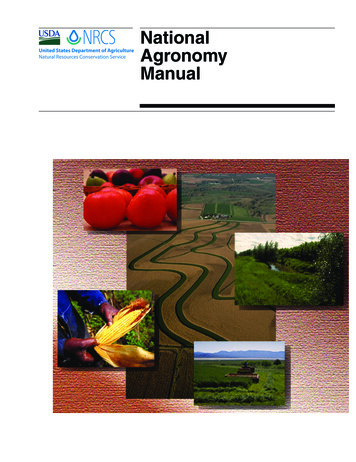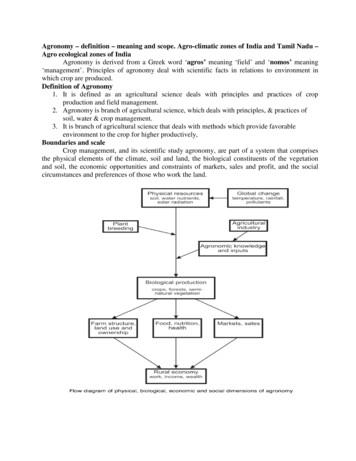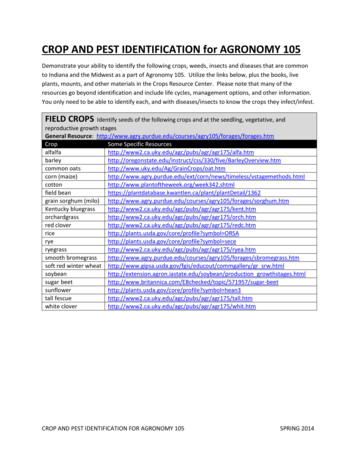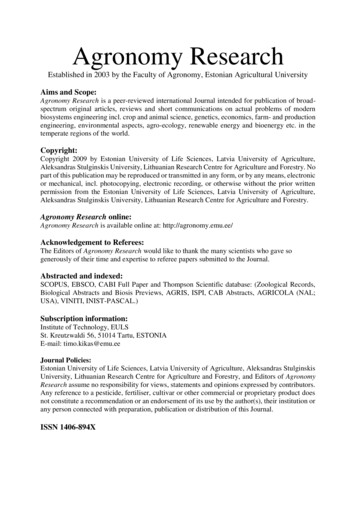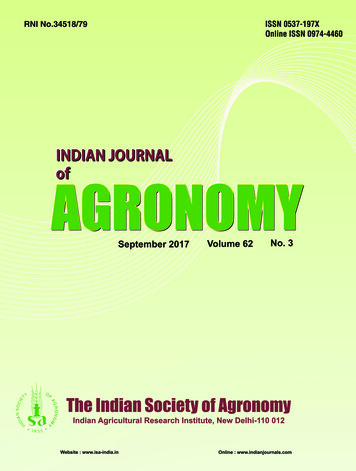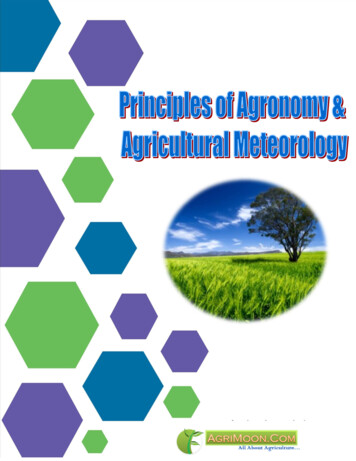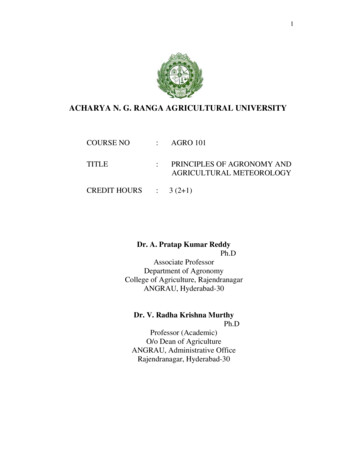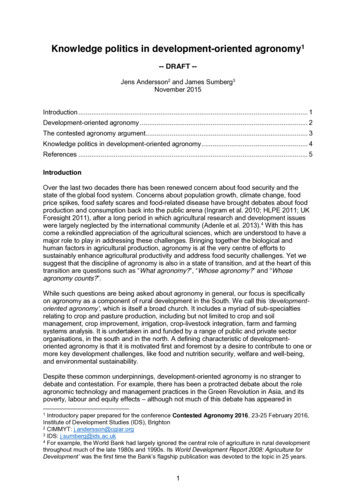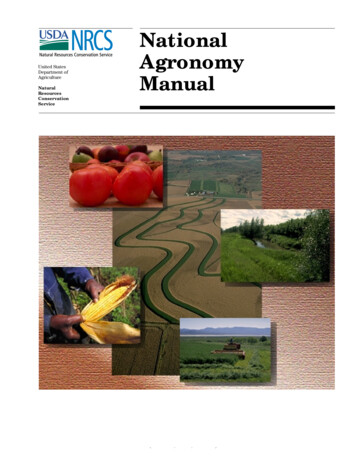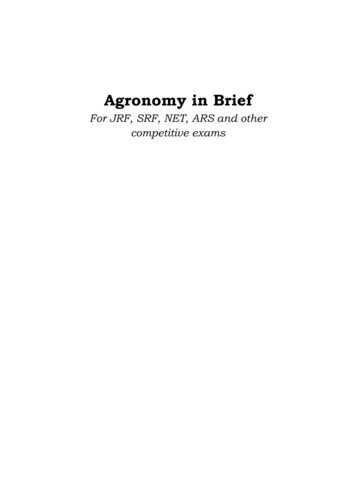
Transcription
Agronomy in BriefFor JRF, SRF, NET, ARS and othercompetitive exams(i)
(ii)
Agronomy in BriefFor JRF, SRF, NET, ARS and othercompetitive examsCompiled & Edited byB. Raghavendra GoudPh.D Scholar, Agronomy,S.V.Agricultural College, Tirupati.Y. Ashoka ReddyPh.D Scholar, Agronomy,TNAU, Coimbatore.G. Prabhakara ReddyProfessor, Agronomy,S.V.Agricultural College, Tirupati, AP.M. Srinivasa ReddyAssistant Professor, Agronomy,Agricultural College, Mahanandi, AP.G. Krishna ReddyPrincipal Scientist, AgronomyRARS, Tirupati, AP.S. SatishPh.D Scholar, Soil Science,S.V.Agricultural College, Tirupati, AP.(iii)
(iv)
PrefaceThere are few books in Agronomy which satisfies the requirements ofstudents particularly preparing for competitive examinations. This bookis designed to satisfy their need and is presented in a systematic mannerto understand every fundamental aspect related to agronomy. This bookcovers all the basic concepts of agronomy viz., tillage, sowing, soil fertilityand nutrient management, water management, weed management,dryland agriculture and sustainable agriculture.Some of the new topicslike climate change, herbicide resistance and herbicide tolerant cropswere also included. Current statistics related to agriculture is alsoprovided for the benefit of the students. This book will be very muchuseful for those students preparing for NET, ARS, JRF, SRF and PG andPh.D entrance examinations. The authors acknowledge theirindebtedness to the authors of various books, bulletins, monographs andperiodicals from which most of the material have been drawn.Tirupati, Andhra Pradesh.Authors(v)
(vi)
CONTENTSCHAPTERNO.TITLEPAGE NO.1Introduction to Agronomy12Agricultural Research Institutes63Botanical Names of Crops174Text Books and their Authors235Journals and their Publishers256Agricultural Meteorology287Soil Environment and its Modification548Problematic soils and Management809Tillage8410Seeds and Sowing9011Plant Population9812Soil Fertility and Nutrient Management10313Growth and Development of Crops15614Dryland Agriculture16815Soil Conservation18216Water Management19117Weed Management21618Cropping and farming Systems26019Maturity and Harvesting26920Quality of Agricultural Produce27921Sustainable Agriculture28222Agroforestry28723Climate Change29224Other Important Concepts29725Agricultural Statistics33826Recent Stastistics and General Agriculture345Selected References369(vii)
(viii)
Chapter 1Introduction to Agronomy The term agriculture is derived from the Latin words ‘ager’ or‘agri’ meaning ‘soil’ and ‘cultura’ meaning cultivation. Agriculture is a very broad term encompassing all aspects of cropproduction, livestock farming, fisheries, forestry etc. Agronomy is a branch of agricultural science which deals withprinciples and practices of soil, water and crop management. Agronomy can also be defined as a branch of agricultural sciencethat deals with methods which provide favourable environment tothe crop for higher productivity. Agronomy is derived from Greek words agros meaning ‘field’ andnomos meaning ‘to manage’. Norman (1980) has defined agronomy as the science ofmanipulating the crop environment complex with dual aim ofimproving agricultural productivity and gaining a degree ofunderstanding of the process involved. Agronomy deals with different management practices like tillage,seeds and sowing, nutrient management, water management,weed management, harvesting, storage and marketing. Agronomy is a synthesis of several disciplines like soil science,agricultural chemistry, crop physiology, plant ecology, entomologyand plant pathology. Agronomy is an art, science and a business. As an art, agronomy refers to the knowledge of the way to performthe operations of the farm in a skillful manner but do notnecessarily include an understanding of the principles underlyingfarm practices. Both physical and mental skills are essential for successful cropproduction. Agronomy is a science, because scientific principles are freelyused for production of quality crops.
2Agronomy in Brief: For JRF, SRF, NET, ARS and other competitive exams Agronomy is a business, because small and marginal farmerstake crop production on subsistence levels but progressive andlarge farmers consider it to maximize production as well as profit.Pietro Decrescenzi is regarded as father of Agronomy.Agrostology is a branch of science which deals with the study ofgrasses, their classification, management and utilization.Environment is defined as the aggregate of all the externalconditions and influences affecting the life and development of anorganism.Crop production is basically conversion of environmental inputslike solar energy, carbon dioxide, water and soil nutrients intoeconomic products in the form of human or animal food orindustrial raw materials.Season for raising each crop has to be selected to attain highestproductivity from available climatic resources.The earliest man, Homo erectus emerged around one and halfmillion years ago and by about a million years ago he spreadthroughout world tropics and later to temperate zones.Homo sapiens, the direct ancestor of modern man lived 250thousand years ago.Homo sapiens sapiens, the modern man, appeared in Africaabout 35 thousand years ago.India’s most important contribution to world agriculture is rice,the staple food crop of most of south, south-east and east-Asia.Sugarcane, number of legumes and tropical fruit like mango arenatives of India.Indian agriculture is predominantly of subsistence type.Several crops like potato, sweet potato, tomato, chillies,groundnut, cashewnut, tobacco, American cotton, arrow root,cassava, pumpkin, papaya, pineapple, guava, custard apple,rubber and were introduced into the country by Portugueseduring 16th century A.D.In pre-scientific agriculture, six persons could produce enoughfood for themselves and for four others. In years of bad harvest,they could produce only enough for themselves.With the development of agricultural science and application ofadvanced technology, five persons are able to produce enough foodfor 95 others.
Introduction to Agronomy 3Scientific agriculture began in India when sugarcane, cotton andtobacco were grown for export purposes.Important events in history of agriculture8700 B.C. – Domestication of sheep7700 B.C. – Domestication of goat7500 B.C. – Cultivation of crops (wheat and barley)6000 B.C. – Domestication of cattle and pigs4400 B.C. – Cultivation of maize3500 B.C. – Cultivation of potato3400 B.C. – Wheel was invented2900 B.C. – Plough was invented2200 B.C. – Cultivation of rice1800 B.C. - Cultivation of finger millet1725 B.C. – Cultivation of sorghum1500 B.C. – Cultivation of sugarcane. Irrigation from wells.1400 B.C. – Use of iron15 Century A.D. – Cultivation of sweet orange, sour orange, wildbrinjal, pomegranate16 Century A.D. – Introduction of crops into India by Portuguese. Experiments pertaining to plant nutrition in a systematic way wereinitiated by Van Helmont (1577-1644 A.D.). Van Helmont claimed that plants require only water to grow andconcluded that the main principle of vegetation is water. Francis Bacon stated that water was the principal nourishmentfor plants. Glauber claimed that plants needed only saltpeter (potassiumnitrate) to grow. Jethro Tull suggested that plant roots directly absorb soilparticles. Jethro Tull conducted experiments on culturaldeveloped seed drill and horse drawn cultivator. Jethro Tull published a book ‘Horse Hoeing Husbandry’. Woodward stated that terrestrial matter or earth rather than waterwas the principle of vegetation.practices,
4Agronomy in Brief: For JRF, SRF, NET, ARS and other competitive exams Thaer regarded soil humus as the source of carbon for plants. Theory of humus formulated in the year 1809. Boussingault first stated that plants derive carbon from air. Liebig is regarded as the founder of modern agriculturalchemistry and enunciator of the Law of minimum (1843). Arthur Young (1741-1820 A.D.) conducted pot cultureexperiments to increase the yield of crops by applying severalmaterials like poultry dung, nitre, gun powder etc. Arthur young published his work in 46 volumes as ‘Annals ofAgriculture’. In 1837, Lawes began to experiment on the effect of manures oncrops. In 1842, Lawes patented a process of treating phosphate rock toproduce superphosphate and thus initiated the synthetic fertilizerindustry. World’s oldest permanentRothamsted, UK. Establishment of long-term field experiments at Rothamsted (UK)in 1834 by Lawes and Gilbert. Long-term fixed plot ‘manurial’ experiments were started at Kanpurin UP, Pusa in Bihar, Coimbatore in Tamil Nadu, Padegaon inMaharashtra, Shanjahanpur in UP. Oldest manurial trials established in India in Kanpur, UP. All manurial trials except Coimbatore had been demolished. Longterm manurial experiment at Coimbatore is still continuing. YL Nene (Virologist) first discovered field-scale zinc deficiency inIndia at Pantnagar. Bray developed nutrient mobility concept in soils. Hellriegel and Wilfarth discoveredatmospheric N with the help of bacteria. Beijerinck isolated the bacteria responsible for N fixation insymbiosis with legumes. Bacillus radicicola was the earlier name of rhizobium. Beijerinck isolated Rhizobium, Azotobacter and Azospirillum. Gregor Johann Mendel discovered laws of heredity in 1866.fieldexperimentsthatlocatedlegumescanatfix
Introduction to Agronomy5 In 1876, Charles Darwin published the results of experiments oncross and self-fertilization in plants. Robert Ransome patented a cast iron share in 1785. DDT was first synthesized in 1874 by Dr. Paul Muller. Wholer first synthesized urea in 1928. In 1870, a joint department of agriculture, revenue andcommerce was established in India. In 1905, Imperial Agricultural Research Institute was started atPusa, Bihar. In 1912, Sugarcane Breeding Institute was established inCoimbatore as a branch of Imperial Agricultural Research Institute. Several agricultural colleges and agricultural research stationswere started in 1929. After the earthquake of 1936, Imperial Agricultural ResearchInstitute was shifted from Pusa to Delhi. Agricultural Universities were started in India from 1964onwards in different states.ROLE OF AGRONOMIST Agronomist aimsminimum cost. Agronomist is concerned with production of food and fibre tomeet the needs of the growing population. Agronomist is a key person working with knowledge of allagricultural disciplines and coordinator of different subjectmatter specialists.atobtainingmaximumproductionat
Chapter 2Agricultural Research InstitutesINTERNATIONAL INSTITUTESAVRDC - Asian Vegetable Research and Development Centre, TaiwanCGIAR - Consultative Group of International Agricultural Research,Washington, USACIAT – International Centre for Tropical Agriculture, Columbia, SouthAmericaCIMMYT – International Centre for the Improvement of Maize and Wheat,MexicoCIP – International Potato Centre, Peru, South AmericaFAO – Food and Agricultural Organization of the United Nations, Rome,ItalyIBPGR – International Board for Plant Genetic Resources, Rome, ItalyIBRD – International Bank for Reconstruction and Development (TheWorld Bank), Washington DC, USAIBSNAT – International Benchmark Soils Network for AgrotechnologyTransfer, Hawai, USAICARDA – International Centre for Agricultural Research in the DryAreas, Aleppo, SyriaICBA – International Centre for Biosaline Agriculture, Dubai, UAEICRAF – International Centre for Research in Agroforestry, Nairobi,KenyaICRISAT – International Crops Research Institute for the Semi-AridTropics, Patancheru, Andhra Pradesh, IndiaIDRC – International Development Research Centre, Ottawa, CanadaIFDC – International Fertilizer Development Centre, Alabama, USAIFPRI – International Food Policy Research Institute, Washington DC,USA
Agricultural Research Institues7IITA – International Institute of Tropical Agriculture, Ibadan, NigeriaILRI – International Livestock Research Institute, Nairobi, KenyaIRRI – International Rice Research Institute, Manila, PhilippinesISNAR – International Service for National Agricultural Research, TheHague, NetherlandISRIC – onCentre,ISSS – International Society of Soil Science, RomeIWMI – International Water Management Institute, Digama, Sri LankaLRDC – Land Resources Development Centre, UKTPRI – Tropical Pesticides Research Institute, Arusha, TanzaniaWAC – World Agroforestry Centre (ICRAF), Nairobi, KenyaWARDA – West Africa Rice Development Association, Monrovia, LiberiaWMO – World Meteorological Organization, GenevaNATIONAL INSTITUTESBARC – ai,CARI - Central Agroforestry Research Institute, Jhansi, Uttar PradeshCARI – Central Avian Research Institute, Izatnagar, Uttar PradeshCAZRI – Central Arid Zone Research Institute, Jodhpur, RajasthanCCRI - Central Citrus Research Institute, Nagpur, MaharashtraCFTRI – Central Food Technological Research Institute, Mysore,KarnatakaCIAE – Central Institute of Agricultural Engineering, Bhopal, MadhyaPradeshCIAH – Central Institute of Arid Horticulture, Bikaner, RajasthanCIARI – Central Island Agricultural Research Institute, Port Blair,Andaman and Nicobar IslandsCIBA – Central Institute of Brackishwater Aquaculture, Chennai, TamilNaduCICR – Central Institute for Cotton Research, Nagpur, Maharashtra
8Agronomy in Brief: For JRF, SRF, NET, ARS and other competitive examsCIFA – Central Institute of Freshwater Aquaculture, Bhubaneshwar,OdishaCIFRI – Central Inland Fisheries Research Institute, Barrackpore, WestBengalCIFT – Central Institute of Fisheries Technolgy, Willingdon Island,Cochin, KeralaCIMAP – Central Institute of Medicinal and Aromatic Plants, Lucknow,Uttar PradeshCIPHET – Central Institute of Post-harvest Engineering and Technology,Ludhiana, PunjabCIRB - Central Institute for Research on Buffaloes, Hisar, HaryanaCIRC – Central Institute for Research on Cattle, Meerut, Uttar PradeshCIRCOT – Central Institute for Research on Cotton Technology,Matunga, Mumbai, MaharashtraCIRG – Central Institute for Research on Goats, Makhdoom, Farah, UttarPradeshCISTH – Central Institute of Sub-Tropical Horticulture, Lucknow, UttarPradeshCITH – Central Institute of Temperate Horticulture, Srinagar, Jammu &KashmirCIWA - Central Institute for Women in Agriculture, BhubaneshwarCMFRI – Central Marine Fisheries Research Institute, Cochin, KeralaCPCRI – Central Plantation Crops Research Institute, Kasargod, KeralaCPPTI – yderabad,CPRI – Central Potato Research Institute, Shimla, Himachal PradeshCRIDA – Central Research Institute for Dryland Agriculture, Hyderabad,TelanganaCRIJAF – Central Research Institute for Jute and Allied Fibres,Barrackpore, West BengalCSIR – Council of Scientific and Industrial Research, New DelhiCSSRI – Central Soil Salinity Research Institute, Karnal, Haryana
Agricultural Research Institues9CSWCRTI – Central Soil and Water Conservation Research and TrainingInstitute, Dehradun, UttarakhandCSWRI – Central Sheep and Wool Research Institute, Avikanagar,RajasthanCTCRI – Central Tuber Crops Research Institute, Thiruvananthapuram,KeralaCTRI – Central Tobacco Research Institute, Rajahmundry, AndhraPradeshCTRL – Cotton Technological Research Laboratory, Matunga, Mumbai,MaharashtraDARE – Department of Agricultural Research and Education, New DelhiFRI – Forest Research Institute, Dehradun, UttarakhandIASRI – Indian Agricultural Statistics Research Institute, New DelhiICAR – Indian Council of Agricultural Research, New DelhiICAR – RCER - ICAR Research Complex for Eastern Region, Patna, BiharICAR - RCNEHR - ICAR Research complex for NEH region, Umiam,MeghalayaIGFRI – Indian Grassland and Fodder Research Institute, Jhansi, UPIIAB – Indian Institute of Agricultural Biotechnology, Ranchi, JharkhandIIFSR - Indian Institute of Farming Systems Research, Modipuram, UPIIHR – Indian Institute of Horticultural Research, Bangalore, KarnatakaIIMR - Indian Institute of Maize Research, New DelhiIIMR - Indian Institute of Millets Research, Hyderabad, TelanganaIINRG – Indian Institute of Natural Resins and Gums, Ranchi, JharkandIIOPR - Indian Institute of Oil Palm Research, Pedavegi, West Godavari,Andhra PradeshIIOR - Indian Institute of Oilseeds Research, Hyderabad, TelanganaIIPR – Indian Institute of Pulses Research, Kanpur, Uttar PradeshIIRR - Indian Institute of Rice Research, Hyderabad, TelanganaIIRS – Indian Institute of Remote Sensing, Dehradun, UttarakhandIISR - Indian Institute of Seed Research, Mau, Uttar PradeshIISR – Indian Institute of Spices Research, Calicut, Kerala
10Agronomy in Brief: For JRF, SRF, NET, ARS and other competitive examsIISR – Indian Institute of Sugarcane Research, Lucknow, Uttar PradeshIISS – Indian Institute of Soil Science, Bhopal, Madhya PradeshIISWC - Indian Institute of Soil and Water Conservation, Dehradun,UttarakhandIIVR – Indian Institute of Vegetable Research, Varanasi, Uttar PradeshIIWBR - Indian Institute of Wheat and Barley Research, Karnal, HaryanaIIWM - Indian Institute of Water Management, Bhubaneshwar, OdishaISI – Indian Statistical Institute, Kolkata, West BengalMANAGE – National Institute of Agricultural Extension Management,Hyderabad, TelanganaNAARM – National Academy of Agricultural Research Management,Hyderabad, TelanganaNBRI – National Botanical Research Institute, Lucknow, Uttar PradeshNCOF – National Centre of Organic Farming, Ghaziabad, Uttar PradeshNIAG – National Institute of Animal Genetics, Karnal, HaryanaNIANP – National Institute of Animal Nutrition & Physiology, Adugodi,Bengaluru, KarnatakaNIASM – National Institute of Abiotic Stress Management, Malegaon,Baramati, Pune, MaharashtraNIBSM – National Institute of Biotic Stress Management, Baronda,Raipur, ChhattishgarhNIHSAD - National Institute of High Security Animal Diseases, Bhopal,MPNIRJAFT – National Institute for Research on Jute Allied FibresTechnology, Kolkata, West BengalNIVEDI – National Institute of Veterinary Epidemiology and DiseaseInformatics, Hebbal, Bengaluru, KarnatakaNOFRI - National Organic Farming Research Institute, Gangtok, SikkimNRRI – National Rice Research Institute, Cuttack, OdishaNRSC – National Remote Sensing Centre, Balanagar, Hyderabad,TelanganaNSI – National Sugar Institute, Kanpur, Uttar PradeshPRII – Potash Research Institute of India, Gurgaon, Haryana
Agricultural Research Institues11SBI – Sugarcane Breeding Institute, Coimbatore, Tamil NaduVPKAS – Vivekananda Parvatiya Krishi Anusandhan Shala, Almora,UttarakhandDEEMED UNIVERSITIES – 4IARI - Indian Agricultural Research Institute, New DelhiNDRI - National Dairy Research Institute, Karnal, HaryanaIVRI - Indian Veterinary Research Institute, Izatnagar, Uttar PradeshCIFE - Central Institute on Fisheries Education, Mumbai, MaharshtraDIRECTORATES/PROJECT DIRECTORATESDirectorate of Groundnut Research, Junagadh, GujaratDirectorate of Cashew Research, Puttur, Dakshina Kannada Dist,KarnatakaDirectorate of Coldwater Fisheries Research, Bhimtal, UttarakhandDirectorate of Floricultural Research, Pune, MaharashtraDirectorate of Knowledge Management in Agriculture, Pusa, New DelhiDirectorate of Medicinal & Aromatic Plants Research, Anand, GujaratDirectorate of Mushroom Research – Solan, Himachal PradeshDirectorate of Onion and Garlic Research, Pune, MaharashtraDirectorate of Poultry Research, Rajendranagar, Hyderabad, TelanganaDirectorate of Rapeseed & Mustard Research, Bharatpur, RajasthanDirectorate of Soybean Research, Indore, Madhya PradeshDirectorate of Weed Science Research, Jabalpur, Madhya PradeshDirectorate of Wheat Research, Karnal, HaryanaProject Directorate on Foot and Mouth Disease, Mukteswar, Kumaon,UttarakhandNATIONAL BUREAUSNBAGR – National Bureau of Animal Genetic Resources, Karnal, HaryanaNBAII – National Bureau of Agriculturally Important Insects, Hebbal,Bengaluru, Karnataka
12Agronomy in Brief: For JRF, SRF, NET, ARS and other competitive examsNBAIMO – National Bureau of Agriculturally Important Micro-Organisms,Mau Nath Bhanjan, Uttar PradeshNBFGR – National Bureau of Fish Genetic Resources, Lucknow, UttarPradeshNBPGR – National Bureau of Plant Genetic Resources, New DelhiNBSS & LUP – National Bureau of Soil Survey and Land-Use Planning,Nagpur, MaharashtraNATIONAL RESEARCH CENTRESNational Centre for Integrated Pest Management, Pusa, New DelhiNational Research centre for Agricultural Economics & Policy Research,Pusa, New DelhiNational Research Centre for Banana, Tiruchirapalli, Tamil NaduNational Research centre for Camel, Bikaner, RajasthanNational Research centre for Equines, Hisar, HaryanaNational Research Centre for Grapes, Pune, MaharashtraNational Research Centre for Litchi, Muzaffarpur, BiharNational ema,National Research Centre for Orchids, Pakyong, Gangtok, SikkimNational Research centre for Pig, Guwahati, AssamNational Research Centre for Pomegranate, Solapur, MaharashtraNational Research Centre for Seed Spices, Ajmer, RajasthanNational Research centre for Yak, Dirang, West Kameng Dist. ArunachalPradeshNational Research Centre on Integrated Farming (ICAR-NRCIF), Motihari,BiharNational Research centre on Meat, Hyderabad, TelanganaNational Research Centre on Plant Biotechnology, Pusa, New Delhi
Agricultural Research Institues13AICRP’s - All India Co-ordinated Research Project All India Co-ordinated Research Project onMeteorology, Santoshnagr, Hyderabad, Telangana All India Co-ordinated Research Project on Agro-forestry, Jhansi,UP All India Co-ordinated Research Project on Application of Plasticsin Agriculture, Ludhiana, Punjab All India Co-ordinated Research Project on Arid Fruits, Bikaner,Rajasthan All India Co-ordinated Research Project on Arid Legumes,Jodhpur, Rajasthan All India Co-ordinated Research Project on Cashew, Puttur,Karnataka All India Co-ordinated Research Project on Cattle Research,Meerut,UP All India Co-ordinated Research Project on Chickpea, Kanpur, UP All India Co-ordinated Research Project on Cotton, Coimbatore,Tamil Nadu All India Co-ordinated Research Project on Dryland Agriculture,Hyderabad, Telangana All India Co-ordinated Research Project on Farm Implements andMachinery, Bhopal, Madhya Pradesh All India Co-ordinated Research Project on Floriculture, IARI, NewDelhi All India Co-ordinated Research Project on Foot and MouthDisease, Mukteshwar, UP All India Co-ordinated Research Project on Forage Crops, Jhansi,UP All India Co-ordinated Research Project on Goat Improvement,Mathura, Uttar Pradesh All India Co-ordinated Research Project onUtilisation, Bhubaneshwar, Odisha All India Co-ordinated Research Project on Groundnut, Junagadh,Gujarat All India Co-ordinated Research Project on Home Science, Pusa,New DelhiAgriculturalGround Water
14Agronomy in Brief: For JRF, SRF, NET, ARS and other competitive exams All India Co-ordinated Research Project on Honeybees, Hisar,Haryana All India Co-ordinated Research Project on Integrated FarmingSystem Research, Modipuram, Uttar Pradesh All India Co-ordinated Research Project on IPM and Biocontrol,Bengaluru, Karnataka All India Co-ordinated Research Project on Linseed, Kanpur, UP All India Co-ordinated Research Project on Long-term FertilizerExperiments, Bhopal, MP All India Co-ordinated Research Project on Maize, New Delhi All India Co-ordinated Research Project on Medicinal and AromaticPlants including Betelvine, Bengaluru, Karnataka All India Co-ordinated Research Project on Micronutrients andSecondary Nutrients and Pollutant Elements, Bhopal, MP All India Co-ordinated Research Project on Mullarp, Kanpur, UP All India Co-ordinated Research Project on Mushrooms, Solan,Himachal Pradesh All India Co-ordinated Research Project on Nematodes, IARI, NewDelhi All India Co-ordinated Research Project on NSP (Crops), Mau,Uttar Pradesh All India Co-ordinated Research Project on Palms, Kasargod,Kerala All India Co-ordinated Research Project on Pearl millet, Jodhpur,Rajasthan All India Co-ordinated Research Project on Pigeonpea, IIPR,Kanpur, UP All India Co-ordinated Research Project on Pigs, Izatnagar, UP All India Co-ordinated Research Project on Potato, Shimla,Himachal Pradesh All India Co-ordinated Research Project on Poultry, Hyderabad,Telangana All India Co-ordinated Research Project on Rapeseed and Mustard,Bharatpur, Rajasthan All India Co-ordinated Research Project on Rice, Hyderabad,Telangana
Agricultural Research Institues15 All India Co-ordinated Research Project on Sesame and Niger,Jabalpur, MP All India Co-ordinated Research Project on Small Millets, GKVK,Bangalore, Karnataka All India Co-ordinated Research Project on Soil Test and CropResponse, Bhopal, MP All India Co-ordinated ResearchRajendranagar, Hyderabad, Telangana All India Co-ordinated Research Project on Soybean, Indore, MP All India Co-ordinated Research Project on Spices, Calicut, Kerala All India Co-ordinated Research Project on Sugarcane, Lucknow,UP All India Co-ordinated Research Project on Sunflower, Safflower,Castor, Hyderabad, Telangana All India Co-ordinated Research Project on Tropical Fruits, IIHR,Bangalore, Karnataka All India Co-ordinated ResearchThiruvananthapuram, Kerala All India Co-ordinated Research Project on Use of Salt-affectedSoils and Saline Water, Karnal, Haryana All India Co-ordinated Research Project on Vegetable and NSP,Varanasi, Uttar Pradesh All India Co-ordinated Research Project on Water ManagementResearch, Bhubaneshwar, Odisha All India Co-ordinated Research Project onJabalpur, MP All India Co-ordinated Research Project on Wheat and Barley,Karnal, HaryanaProjectProjectononSorghum,TuberCrops,Weed Science,NETWORK PROJECTS All India Network Project on Jute and Allied Fibres, Barrackpore,West Bengal All India Network Project on Pesticides Residues, New Delhi All India Network Project on Rodent Control, Jodhpur, Rajasthan
16Agronomy in Brief: For JRF, SRF, NET, ARS and other competitive exams All India Network Project on Tobacco, Rajahmundry, AndhraPradesh All India Network Project on Underutilised Crops, New Delhi Network on Agricultural Acarology, Bangalore, Karnataka Network on Economic Ornithology, Hyderabad, Telangana Network ProgrammeRajasthan Network Project on Animal Genetic Resources, Karnal, Haryana Network Project on Bio-fertilizers, Bhopal, Madhya Pradesh Network Project on Buffaloes Improvement, Hisar, Haryana Network Project on Harvest and Post Harvest and Value Additionto Natural Resins & Gums, Ranchi Network Project on Improvement of Onion and Garlic, Pune,Maharashtra Network Project on R&D Support for Process Upgradation ofIndigenous Milk Products for Industrial Application, Karnal,HaryanaonSheepImprovement,Avikanagar,
Chapter 3Botanical Names of CropsEnglish/Hindi NameBotanical NameFamilyCEREAL CROPSRice (Found in Asia, America Oryza sativaand Europe)Poaceae (Gramineae)Rice (Found in West Africa)Oryza glaberrimaPoaceae (Gramineae)Common bread wheat/Mexican dwarf wheatTriticum aestivumPoaceae (Gramineae)Macaroni/durum wheatTriticum durumPoaceae (Gramineae)Indian dwarf wheatTriticumsphaerococcumPoaceae (Gramineae)Emmer wheatTriticum dicoccumPoaceae (Gramineae)Einkorn wheatTriticum monococcumPoaceae (Gramineae)MaizeZea maysPoaceae (Gramineae)SorghumSorghum bicolorPoaceae (Gramineae)BarleyHordeum vulgarePoaceae (Gramineae)OatAvena sativaPoaceae (Gramineae)TriticaleTritico secalePoaceae (Gramineae)RyeSecale cerealePoaceae (Gramineae)Pearl milletPennisetum glaucumPoaceae (Gramineae)Finger millet/RagiEleusine coracanaPoaceae (Gramineae)Foxtail millet (Italian millet)Setaria italicaPoaceae (Gramineae)Kodo milletPaspalumscrobiculatumPoaceae (Gramineae)Little millet/ kutkiPanicum sumatrensePoaceae (Gramineae)Proso millet/cheenaPanicum miliaceumPoaceae (Gramineae)Barnyard millet/SawanEchinocloafrumentaceaPoaceae (Gramineae)MILLETS
18Agronomy in Brief: For JRF, SRF, NET, ARS and other competitive examsPULSE CROPSChickpeaPigeon pea (Red gram)LentilGreen gram (Moong)Black gram (Urd)CowpeaField peaGarden s (Grass pea)Moth beanRice beanHorse gramLablab beanOILSEED CROPSRapeseed and mustardMustardIndian mustard/Leafmustard/ Brown mustardBlack mustard/truemustard/banarasi raiEthiopian mustard/AfricanmustardRapeseedYellow sarsonBrown sarsonIndian rape/ToriaCicer arietinumCajanus cajanLens culinarisVigna radiataVigna mungoVigna unguiculataPisum sativum var.arvensePisum sativum var.hortenseCyamopsistetragonolobaPhaseolus osae)Lathyrus sativusVigna acontifoliaVigna umbellataMacrotylomauniflorumLablab purpureusFabaceaeFabaceaeFabaceaeFabaceaeBrassica sp.Brassicaceae (Cruciferae)Brassica junceaBrassicaceae (Cruciferae)Brassica nigraBrassicaceae (Cruciferae)Brassica carinataBrassicaceae (Cruciferae)B. rapa ssp. oleiferavar. yellow sarsonB. rapa ssp. oleiferavar. brown sarsonB. rapa ssp. oleiferavar. toriaBrassicaceae (Cruciferae)Fabaceae (Leguminosae)Fabaceae (Leguminosae)Fabaceae e)(Leguminosae)Fabaceae (Leguminosae)Brassicaceae (Cruciferae)Brassicaceae (Cruciferae)
Botanical Names of CropsSummer rape/Winterrape/Swede rape/GobhisarsonRocket salad/TarmiraSesameSunflowerGround nutLinseedSafflowerNigerSoybeanCastorFIBRE CROPSWhite JuteTossa JuteUpland/American CottonDesi CottonAsiatic cotton19B. napus ssp. Oleifera Brassicaceae (Cruciferae)Eruca sativaSesamum indicumHelianthus annuusArachis hypogaeaLinum usitatissimumCarthamus tinctoriusGuizotia abyssinicaGlycine maxRicinus communisCorchorus capsularisCorchorus olitoriusGossypium hirsutumGossypium arboreumGossypiumherbaceumSea Island or EgyptianGossypiumCottonbarbadenseMestaHibiscus sabdariffaSunnhempCrotalaria junceaKenafHibiscus cannabinusWhite RamieBoehmeria niveaGreen RamieBoe
2 Agronomy in Brief: For JRF, SRF, NET, ARS and other competitive exams Agronomy is a business, because small and marginal farmers take crop production on subsistence levels but progressive and large farmers consider it to maximize production as well as profit
